-
- Nagorno-Karabakh Map
|
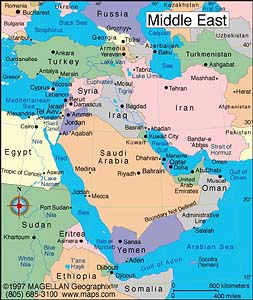  -
- Mid-East Map
Caucasus Map
|
|
-
|
- latest picture: July
15, 2013
|
-
-
Remarks to Nagorno-Karabakh:
-
-
Nagorno-Karabakh belongs to the so-called “countries with
limited recognition”, like e.g.
Abkhazia, Kosovo, Northern
Cyprus, Palestine, Somaliland, South Ossetia,
Taiwan,
Transnistria, Western Sahara,
Crimea, Donetsk and Luhansk. All are either “claimed” or “occupied” from another country.
-
- Hence Nagorno-Karabakh
is claimed by
Azerbaijan,
but declared 1992 its independence and is supported herein by
Armenia.
That means for tourists that they – with the exception of just a few –
cannot expect much assistance from their home country if something
went wrong. Azerbaijan forbids any visit of – in their view –
its defected province of Nagorno-Karabakh.
However it can be visited from the Armenian side without any problem.
The border from Nagorno Karabakh to
Iran
is closed.
|
-
-

|
-
-

|
-
-

|
- 001
Coming from Armenia a sign
shows
- in Armenian, English, Russian and French
- that we are now entering the self proclaimed
- Republic of Nagorno-Karabakh, which is
- not recognized by the international
- community .....
|
- 002
..... it is situated behind these
- mountain ridges. Internationally it is
- recognized as a part of Azerbaijan
despite
- that ethnically the people are more Armenia
- related. Both are Christians (Armenia
- Apostolic Church), while Azerbaijan’s
- majority adheres to Shia Islam
|
- 003
Nagorno-Karabakh has an own flag
- and passports, but neither own license plates
- nor its own money. They have adopted both
- from Armenia that was supporting them
- during the several secession wars from
- Azerbaijan between 1988 and 1994
|
| “We are
not able to offer you any consular assistance in Nagorno Karabakh as
this country is not recognized internationally.“ These are the
unambiguous words of our consulate in Tbilisi in
Georgia. Despite of this clear statement,
on July 9th, 2013, we are on our way to this on September 2nd, 1991,
self declared independent state, which is still claimed by Azerbaijan.
During our almost 29 years of traveling, we luckily never needed to
bother a Swiss representative. Thus we hope that also in our 176th
country luck won’t abandon us. |
-
-
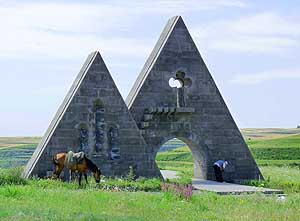
|
-
-

|
-
-

|
- 004
The pyramid shaped “entrance
- monument” of Nagorno-Karabakh between
- border sign and border post. Actually the
- monument is located on Azerbaijan
- territory, because Nagorno-Karabakh
- starts only after the village of Berdzor
|
- 005
After the checkpoint on the
- Aghavno River the nice little church of
- Berdzor in a hilly setting is one of our first
- pictures on the 25 miles long mountain road
- to the country’s capital Stepanakert
|
- 006
Stepanakert, the capital with its
- 60'000 people lies on 2’670 ft. and is
- surrounded by forest, pasture, hills and
- mountains. It’s clean and makes a
- European like impression
|
| Already
before the border post, a sign with the letters “Republic of Mountainous
Karabakh” appears. It is written in Armenian, English, Russian and
French and reminds us that we are entering new land. Shotly afterwards,
a modest building already marks the border of the self declared country
of Nagorno Karabakh. Its new flag is fluttering in the wind. At the only
window we submit our passeports, but get no stamp. Merely our personal
data is noted. Giving us the address of its Ministry of Foreign Affaires
in the 25 miles distant capital Stepanakert, we are asked to apply there
for a visa. “And our car?”, we wonder anxiously. “Not at all a problem”.
The friendly officer takes off our worries immediately. |
-
-

|
-
-

|
-
-

|
- 007
This is the 10 days visa that we
- obtained on a sheet of paper (not into
the
- passport) from Ministry of Foreign Affairs
- of Nagorno-Karabakh in the capital (US$ 8).
- It mentions also the travel route (at the border
- post only our personal data was recorded)
|
- 008
The most important buildings are
- situated more or less around the same
- square (parliament, presidential palace,
- ministries, national museum etc.) .....
|
- 009
..... Presidential Palace
- (President Bako S. Sahakyan) .....
|
| Nagorno
Karabakh has an own flag and own passports, own stamps but neither own
car licence plates nor own money nor an own internet domain. They have
been taken over all from Armenia, the
country to which they feel related. People are from the same ethnic
group; both are Christians. It is also Armenia that supports the region
that defected from Azerbaijan after the
collapse of the Soviet Union and the following 1991 wars. Even road
construction is sponsored by Armenia. |
-
-
-
-

|
-
-

|
-
-
-
-

|
- 010
..... Vallex-Garden Hotel
|
- 011
Even more than one year later, on
- 7/11/2013 – on our visit to Stepanakert –
- the “Liberation of Shushi” 20 years ago is
- still commemorated: On 5/8/1992 the
- Armenians expelled the Azerbaijanis
- from Shushi
|
- 012
Parliament Building
|
| There
is hardly any traffic when we wind our way over the mountain road with
its many curves and switchbacks towards the capital Stepanakert. On the
summit of Lisagor (5’988 ft. [1’825m]) we find a flat spot with lovely
views for our lunch break. While I prepare hash browns, cooked ham and
green salad, Emil jacks up the rear wheel and turns it. Since a couple
of days he hears a too familiar noise worrying him. Now he wants to have
certainty. When I hear him swear I already know that it is again the
bloody axle shaft – no wonder after all the hard bangs during the past
weeks on Armenians miserable roads. |
-
-

|
-
-

|
-
-

|
- The Saturday market in Stepanakert leaves nothing to desire
regarding fruits and vegetables.
- In addition also the choice of dried fruit and nuts is big. And
home made honey and marmalade belong also to the offer
|
- 013
|
- 014
|
- 015
|
|
Stepanakert – Azerbaijani Xankəndi – the capital with its ca. 60‘000
inhabitants makes a clean impression. It bears European characteristiques. Our first step is to call at the Ministry of Foreign
Affairs and fill out our visa application. Required are also the names
of the places we intend to visit – exactly like in earlier times it was
with the ‘marsh route’ in Russia. They are also mentioned in the 10 days
visa that is handed over on a separate sheet of paper. From our travel
route nothing is rejected except Agdam – a town with 150‘000 people that
was completely erased during the 1994 war with Azerbaijan and lies on
the still sensible ceasefire line. This place is tabu for tourists. The
procedure lasts less than 15 minutes and after having paid AMD 3‘000
each (US$7.50) we are allowed now to roam around freely. |
-
-

|
-
-

|
-
-
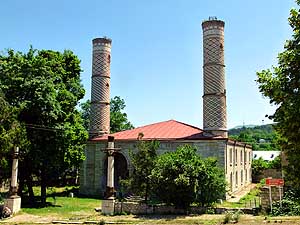
|
- 016
On a plateau, 6 miles south from
- Stepanakert, lies Shushi, the "City of
- Speaking Stones", with its 1½ mile long
- fortification wall, built 1750. In the
- 19th century it was one of the largest
- towns in the South Caucasus .....
|
- 017
..... during the repeated war with
- Azerbaijan there was done much
damage
- to the city. In March 1920 within only
- three days ⅔ of Shushi was burnt
- to the ground .....
|
- 018
..... the Ashaghi Govhar Agha
- Mosque with its two tall brick minarets,
- built in 1883, will now be restored. It has
- not been demolished during the wars. In
- return the Armenian Church in Baku is
- also tolerated, though only as a library
|
| We
start looking for a hotel. The rooms in Stepanakert are too expensive
(about US$55). But 6 miles [9km] south, in Shushi (4’450 people),
situated on a lovely plateau and surrounded by high fortified walls,
built 1750, we find a very comfortable bright room at the Shushi Hotel.
It costs only half and offers Wi-Fi and breakfast. The small town has
suffered heavily under the Nagorno Karabakh war, but reconstruction is
on its way. The best evidence is the renovated Ghazanchetsots Cathedral
right opposite our hotel. It was built 1888 and is an architectural
masterpiece, dominating the city landscape. |
-
-

|
-
-

|
-
-

|
- 019
An architectural masterpiece,
- dominating the city landscape, is the 164 ft.
- tall renovated Ghazanchetsots Cathedral in
- Sushi, founded 1888. We booked into the
- "Hotel Shushi" right opposite, with a little
- "parking" for our LandCruiser .....
|
- 020
..... on this parking Emil has to
- replace once more the rear axle shaft.
- Despite that we have a lot of exercise,
- this time it does last six instead of
- usually four hours
|
- 021
Simply ingenious: Drying clothes
- by cable haulage between residence
- buildings in Shushi
|
| Flocks
of swallows fly past our window when we get up. Already at 7am we sit at
the breakfast table; we are the only guests. What is being served is a
real cholesterol-bomb: Two eggs each, cheese, butter, whipped cream –
common in Russia – marmalade, bread and tea. In tea countries like this
we got used to bring our own Nescafe and ask for hot water. Because
without three cups of coffee in the morning, nothing works with Emil. |
-
-
-
-

|
-
-

|
-
-
-
-
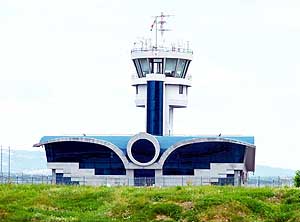
|
- 022
“Papik u Tatik” (i.e. “we are our
- mountains”) – that is the name of the 1967
- built tufa monument of a bearded elder and
- a woman with a veil. It is on the outskirts
- of Stepanakert direction Askeran
|
- 023
At the main square in Stepanakert
- the little sister hides shyly behind her
- "big" brother
|
- 024
The futuristic and fully operational
- airport of Stepanakert is not (yet) in function,
- because Azerbaijan threatened to
possibly
- shoot down from the ceasefire line – that is
- only 25miles away – also civilian aircrafts
|
| Next
morning we visit Shushi which was heavily damaged by the repeated war
with Azerbaijan. Alone in March 1920, ⅔ of
the city has been burnt to the ground in only three days. It’s only when
1920 the Bolsheviks (later Soviet Union) invaded Azerbaijan and
Armenia, that peace returned to the
region. Soon we have enough of the depressing sights. To cheer us up, we
drive the six miles [9km] downhill to the capital and stroll around. The
most important buildings like parliament, presidential palace,
ministries, national museum – all are grouped around the same square and
each architecture is impressive in its own way. Yes, and there is a
pizzeria where Emil orders one of his favorite cheese dishes and I eat
risotto with mushrooms. |
-
-

|
-
-

|
-
-

|
- 025
Dandelion (Taraxacum) or may
- be not? In our childhood we always
- blew its seeds away
|
- 026
The landscape from Stepanakert
- to the Gandzasar Monastery near
Vank
- in the north is characterized by forest,
- pasture and rolling hills
|
- 027
A bush of pink gilly-flowers
- (Dianthus orientalis) is growing
- out of a rock crevice
|
| The
risotto triggers a chain of reactions. It is to blame that Emil gets out
on the wrong side of the bed. During the night I get diarrhea which
makes me constantly hop between bathroom and bed. And this gave Emil a
bad night’s sleep. He is grumpy and in bad mood. He uses it as
opportunity to let off more steam. He complains about the hated Windows
8 system with which our new Lenovo Laptop is equipped, about the axle
shaft that he will have to exchange soon, about our website that lies
idling due to lack of time, about the many bad roads and once more about
my noisy snoring. Yes, the day has seen better mornings! |
-
-

|
-
-

|
-
-

|
- 028
About 34 miles north of Stepanakert
- in a lovely hill setting near Vank is the
- 13th century Gandzasar Monastery with its
- excellent Armenian architecture,
rich friezes
- and magnificent details .....
|
- 029
..... well preserved inscriptions
- adorn a wall of the Cathedral of “Saint
- John the Baptist” of Gandzasar .....
|
- 030
..... the central dome is adorned
- with exquisitely carved high reliefs (friezes).
- Unfortunately the Gandzasar Monastery
- suffered damages through the Armenian-
- Azerbaijani Nagorno-Karabakh conflict
- whereby a building was totally destroyed
|
| Towards
noon we check out of the Hotel Shushi and drive in northerly direction
to the 13th century Gandzasar Monastery. It sits in a lovely hill
setting near Vank, 34 miles [55km] from Stepanakert. Despite that we
have already seen many monasteries, we still get enthusiastic about its
exquisite carvings, wonderful reliefs, beautifully elaborated “Khaskars”
(medieval carved cross stones), well preserved inscriptions and
magnificent details. Although it is a weekday, it is crowded. The main
holiday season just began. We edge away and stop at a cozy river spot
down in the valley for our lunch break. |
-
-

|
-
-

|
-
-

|
- 031
Chilingaryan family tree in a corner
- of the Gandzasar Monastery
|
- 032
There is no monastery without the
- beautifully elaborated "Khachkars", the
- medieval carved cross-stones. This one
- stands at the Gandzasar Monastery .....
|
- 033
..... next to is another masterpiece
- with a bird motive
|
| There
is still another attraction in the vicinity: The Dadivank Monastery. Are
we missing out on something if we do not visit it? It is incredible, but
also after 29 years of traveling, we still bring up this question. This
time, however, we give in. The road is said to be bad and we already had
our share of bad roads. Instead we choose the route to Drombon and then
to Martakert and come in a way from ‘jumping out of the frying pan into
the fire’. It is in such a desolate potholed condition that it is a
constant struggle. To top it, it mostly runs through dense forest,
giving us only once a short glimpse of the Sarsang reservoir, actually
the reason we have chosen this way. |
-
-
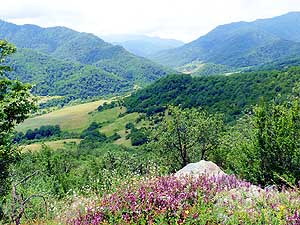
|
-
-
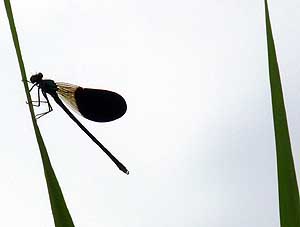
|
-
-

|
- 034
The hilly forested land has a touch
- of Switzerland: View from the Gandzasar
- Monastery towards the western part of
- the Khachen Valley
|
- 035
A blue dragonfly (Odonata)
- rests on reed
|
- 036
We honestly have to earn the
- short glimpse of the Sarsang reservoir
- between Drmbon and Martakert.
- The road conditions are miserable
|
| At the
village of Martakert we turn South and follow the ceasefire line agreed
with Azerbaijan. What we see is a dramatic scene of destruction. For
many miles we pass bombarded villages, burnt out and rusting war relicts
and two men bunkers – silent witnesses of the war fought between 1990
and 1994. Also many years after the end of the war people have not
returned to this sensitive area. Only shrubs and trees are sprouting
again. All the more we are excited when in the soft evening light the
Tigranakert Fortress, called also Shahbulag Castle, appears. It dates
back to the 18th century and was restored in 2010. The main entrance is
still open. But soon we realize that today the castle yard is occupied
by a group. It is practising for an opera performance. A ladies band is
tuning in and actors in colorful costumes are getting ready. We are
allowed to sniff around for a while and then we leave. It is time to
look for a place to sleep. |
-
-

|
-
-

|
-
-

|
- 037
Between Martakert and Aghdam
- we drive along the ceasefire line. For
- many miles we see nothing than
- bombarded villages
|
- 038
Another memorial of the dramatic
- Nagorno-Karabakh war between 1990
- and 1994: The tank monument at Chldran
- along the North-South-Highway (besides
- the tanks of Shushi and Askeran)
|
- 039
Also many years after the end of the
- war people have not returned to this sensitive
- area along the ceasefire line with
Azerbaijan.
- Only shrubs and trees are sprouting again –
- here between Martakert and Aghdam
|
| Right
next to the fortress a narrow path leads towards the mountains. Without
to hesitate we follow it. There is not a house in sight. When the gap is
enough big to the fortress, we set up camp at an even spot beside the
track, just in time to enjoy the silhouette of the Vankasar Church on
the hillltop, engulfed by the reddish skies of the sunset. What a
beautiful sight! |
-
-

|
-
-

|
-
-

|
- 040
The recently (2010) reconstructed
- fortress of Tigranakert from the 18th century
- is situated in the northeast, about 20 miles
- from the capital. Artsakh’s (Nagorno-
- Karabakh’s) Tigranakert excavation site
- is one of the four cities built by "Tigran
- the Great" or his father “Tigran I”
- around 123–95 B.C. .....
|
- 041
..... when we arrive in the evening,
- a group of actors are getting ready for an
- opera performance. In a corner a ladies
- band is tuning in .....
|
- 042
..... three colorful costumed ladies
- are waiting for the event to start
|
| “You
are not allowed to stay here” is the early morning greeting of two well
dressed men just when Emil is putting up our camping table for
breakfast. We are taught that we are on an archaeological site. Yes,
last night we have seen the stone walls and fundaments, but did not pay
any closer attention as we thought they were also war ruins. Well, we
pack up and move to the other side of the bridge where there is open
land. The first rays of sun just come up and catch the fortress, flowers
are blooming around us, a lonely horseman gallops past us with a
friendly smile and down at the river dragonflies flatter from blossom to
blossom. It all makes our day. However before leaving the Tigranakert
Fortress, we take our time to visit the interesting museum within the
walls. We learn in well kept displays about the excavations of the
ancient site that have been underway already for a few years. |
-
-

|
-
-

|
-
-

|
- 043
Around the Tigranakert fortress
- the archeological excavations are under
- way. A new museum within the fortress
- walls has excellent information about it
|
- 044
Our lovely night spot between trees
- with views of the Tigranakert Fortress and
- the Vankasar Church offers us quietness
- and relaxation
|
- 045
The Vankasar Church on the hilltop
- above the Tigranakert Fortress, engulfed by
- the reddish skies of the sunset. It can be
- reached in an hours’ hike
|
| Then we
continue to follow the ceasefire line where the sight of destruction of
the Nagorno Karabakh war is endless and depressing. At the junction to
Aghdam we hesitate. It is the place, which the Ministry of Foreign
Affairs excluded in our travel permit. It is tempting, but we are not
looking for troubles and take the detour. |
-
-

|
-
-

|
-
-

|
- 046
At the intersection to Aghdam, a
- town with a population of 150'000 before
- the war, stands a red prohibition sign. Our
- travel permit from the Ministry of Foreign
- Affairs of Nagorno-Karabakh does not
- include a visit to the ghost town of Aghdam
- and we have to take the bypass .....
|
- 047
..... from far we see only two
- minarets rising to the sky – a visit would
- have been tempting. The town is deserted.
- The people were either massacred or
- they fled to Azerbaijan
|
- 048
This sign says that this region
- has been cleared of mines and is
- accessible again
|
| It is
towards noon when we are back in the capital Stepanakert and buy some
fruits and vegetables on the well-stocked Saturday market. We head then
straight southwest to the more than 2'000 years old giant platanus tree
“Tnjri” near Karmir Shuka. The 15 miles [24km] long road runs firstly
through the impressive two miles [3km] long and 820 ft. [250m] deep
“Hunot” Gorge and then through lovely, little populated hill country.
Now and then steam rises from huge caldrons along the roadside. People
boil corncobs on log fires, hoping to sell them and earn some Drams.
After an hour’s drive, we reach our destination. |
-
-

|
-
-

|
-
-

|
- 049
This rusting war relict is one of many
- that we see along the former frontline
|
- 050
The bunker between the deserted
- hills before Askeran was built in an
- enviously beautiful landscape. It’s an
- Armenian respectively
Nagorno-Karabakh
- relict. The former Soviet border line runs
- between the “Azerbaijan SSR” and the
- “Nagorno-Karabakh Autonomous Oblast”
|
- 051
A remembrance picture with Emil and
- our LandCruiser at the tank monument north
- of Askeran – one of the three we have
- seen in Nagorno-Karabakh (besides Sushi
- and Chldran). It was here that on 2/20/1988
- the Nagorno-Karabakh conflict was ignited
|
| It is
awe-inspiring indeed when we are standing in front of the tree: >2000
years old – about 25 human lives – though a bit damaged and needy of
support. But with its 474 sq.ft. [44m²] hollowed trunk and its more than
177 ft. [54m] height it leaves quite an impression on us. After the eye
is satisfied, our empty stomach wants some attention. With views to the
valley stretching below us I prepare the beans in the pressure cooker I
bought a couple of hours ago at the market in Stepanakert. With it goes
hot knackwurst still from ‘Carrefour’ in Tbilisi in
Georgia. Full and content we return to
Shushi where we stay again at the same hotel. |
-
-
-
-

|
-
-

|
-
-
-
-

|
- 052
7 miles northeast of Stepanakert lies
- Askeran with its fortress which has a huge
- medieval wall, built 1751, that once
- stretched one mile across the valley.
- Already back then it served as a shield to
- protect Shushi against Persian campaigns
|
- 053
Just trickling, but still beautiful:
- A waterfall along the "Hunot Canyon"
- south of Stepanakert .....
|
- 054
..... the "Hunot Gorge" is two miles
- long and 820 ft. deep. It is regarded as
- one of the most beautiful natural sites in
- Nagorno-Karabakh
|
| We have
not yet fully used our 10 days stay. Why don't we add a working day?
Conditions are ideal. Emil replaces the points and spark plugs and
adjusts the ignition. He checks also the compression. It is between 8
and 7½, not ideal but acceptable. I am updating my diary and read. But
next day we pack and carry our bags to the car. “I quickly jack-up the
wheel again to see if the noise of the axle has intensified” Emil
mentions casually. No sooner said than done. The expression on his face
spells trouble. “It sounds worse than a couple of days ago. May be we
make it back to Armenia, may be not” he
assesses the situation. No, to hit the road with the constant worries to
have to do this big work right on the spot along the road does not seem
right. All too well we remember a case in India. There, it happened at a
dusty bend and each time a car passed with unabated speed we were
completely covered with dust. “Why do we not
change the rear axle now and here?” I suggest to Emil. “The location is
good and quiet and in our room we have a hot shower”. Despite that we
have practice in changing axles – it is our “don't know how manyeth” –
this time it is a backbreaking work beneath and beside
of the car. Not
everything is going as smooth as it ought to be. Instead of the four
hours it usually takes, today the struggle lasts for six hours. Emil’s
comment on it: “Now I am also five years older than last time!”
Whatsoever, in the evening we are completely exhausted. We relax with
some well deserved beers, take a hot shower, and
lie in a bed with fresh sheets. Today we definitely don't need any
bedtime story! |
-
-

|
-
-

|
-
-
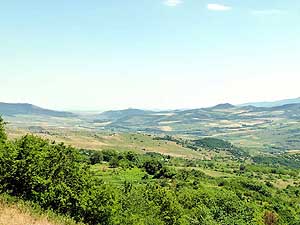
|
- 055
2000+ years – around 25 human
- lives – counts this although a bit damaged
- and support needing giant platanus (plane)
- tree, called “Tnjri”, near Karmir Shuka
- (about 15 miles southwest of Stepanakert)
- on the North-South-Highway to Hadrut
- in southern Nagorno-Karabakh .....
|
- 056
..... with its huge hollowed trunk
- (474 sq.ft.) and the elevated bushy foliage
- the more than 177 ft. tall tree leaves
- quite an impression on us .....
|
- 057
..... from our lunch spot near the
- historic tree we have a lovely view down
- to the far valley where its plains belong
- already to Iran
|
- July 17th, 2013, is the day: After eight days, we return to
Armenia. We are honking and waving good-bye to the lovely hotel
ladies who read every wish from our eyes. They wave back until we
disappear around the corner. Again it is a place where we feel sadness
when leaving. We loved the country and its people. But this is
obviously the inevitable destiny of travelers like us!
The many bends of the mountain pass bring us back to the Armenian
border. Arriving at the customs house, we step out of the LandCruiser
and walk towards the window to submit the visa sheets we obtained in
the capital. But the customs officer already meets us halfway and
stretches out his hand for the paper. Can a border crossing be easier?
Again we experienced that the warnings of the travel advisories were a
bit exaggerated. There was not one moment we had worries about
security or not entirely cleared mines. We really hope that the
present ceasefire with
Azerbaijan will soon give way to a permanent
peace. The friendly people of Nagorno Karabakh deserve it!
Postscript (6/2017): Unfortunately during all the years following our
visit, clashes and sporadic fights continued.
|
- Back to the 1st part of the Armenian trip:
Armenia Part 1
– July 2 to 9, 2013, from
Georgia
Part 2a to
Nagorno-Karabakh
- Continuation to the next Armenian page:
Armenia Part 2
– July 19 to 22, 2013, from Nagorno-Karabakh
to Georgia
Part 2b
|
-
- The "Greater"-Middle East trip 2012/13:
- Sharjah/Dubai/1st Traveler's Festival/Emirates
National Auto Museum - UAE with
car Nov. 2012 to Jan. 2013 - part 1
- Western UAE - Liwa - United Arab Emirates with car in January 2013 - part 2
- Oman 2013 - Part 1 - February
2013: Musandam Peninsula
- Oman 2013 - Part 2 - February
2013: Sohar - Muscat - Rustaq - Nizwa
- Oman 2013 - Part 3 - March
2013: Sur - East Coast - Island of Masirah - Dhofar
- Oman 2013 - Part 4 - March
2013: Salalah & Surroundings (Dhofar) - Nizwa
- Oman 2013 - Part 5 - March 2013: Western Hajar
Mountains
- Al Ain, Eastcoast & Ras al Khaima - United
Arab Emirates with our car in April 2013 -
part 3
- Iran -
Part 1: Ferry Port Bandar Abbas-Shiraz-Persepolis-Pasargad (between Persepolis and Yazd)
– May 2013
- Iran -
Part 2: Pasargad
(excl.)-Yazd-Esfahan – May 2013
- Iran -
Part 3: Esfahan
(excl.)-Chelgerd-Hamadan-Sanandaj-Orumiyeh – May 2013
- Turkey: Iran Border-Esendere-Hakkari-Van-Doğubayazıt-Kars-Ardahan-Hopa-Georgia
Border – May/June 2013
- Georgia -
Part 1: Ajaria-Gori-Tbilisi-Kakheti-Azerbaijan
Border – June 2013
- Azerbaijan:
Georgia Border-Balakən-Şəki-Lahıç-Baku-Xınalıq-Quba-Laza-Baku-Gəncə-Georgia Border – June 2013
-
Georgia - Part 2a: Azerbaijan Border-Tbilisi-Armenia
Border –
June/July 2013
- Armenia -
Part 1: Georgia Border-Haghpat-Dilijan-Sevan-Tatev-Goris-Nagorno-Karabakh – July 2013
- Armenia
- Part 2: Nagorno Karabakh-Goris-Tatev-Noravank-Khor Virap-Echmiadzin-Geghard-Gyumri-Georgia – July 19 to 22, 2013
- Georgia -
Part 2b: Armenia Border-Ninotsminda-Tbilisi-Mtskheta-Kazbegi-Kutaisi-Zugdidi –
July 2013
- Georgia -
Part 3a:
Zugdidi-Swaneti-Zugdidi-Abkhazia Border – July/August 2013
- Abkhazia: Georgia-Sukhumi-Tsebelda-Novyy Aton-Lake
Ritsa-Gagra-Pitsunda-Georgia – August
2013
- Georgia - Part 3b: Abkhazia Border-Poti-Ferry to Ilyichevsk/Ukraine
– August 2013
|
|
|
![]()




























































